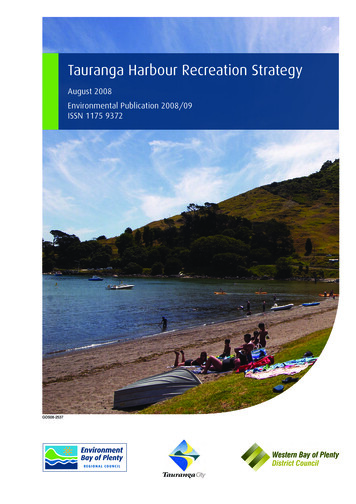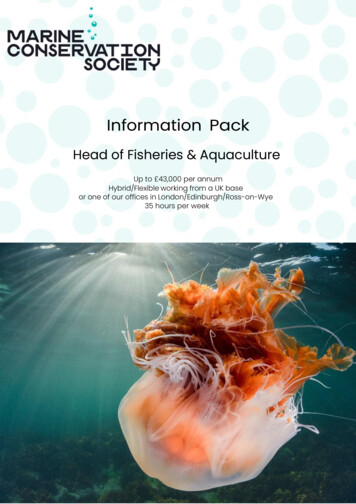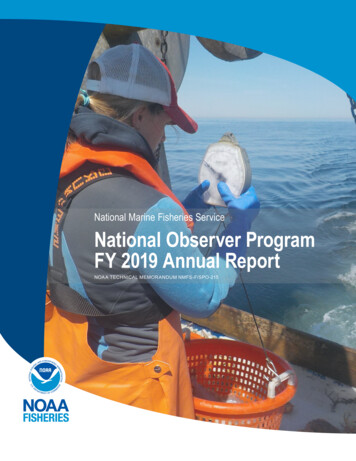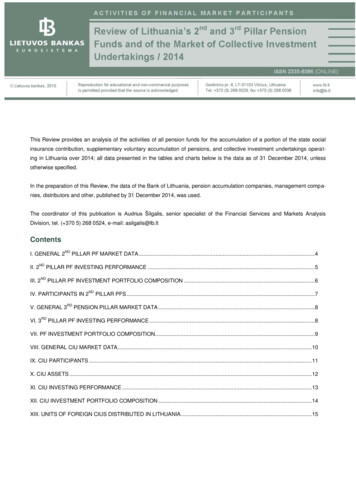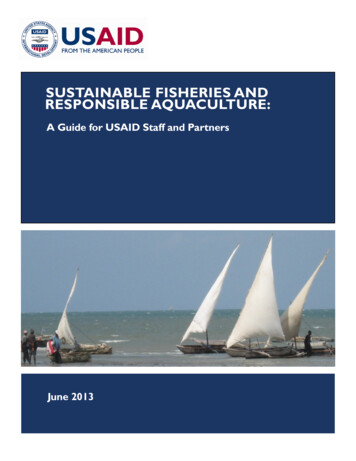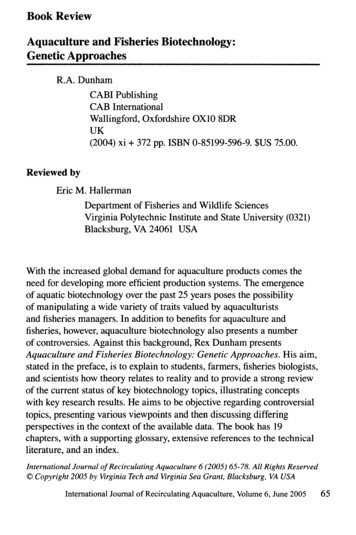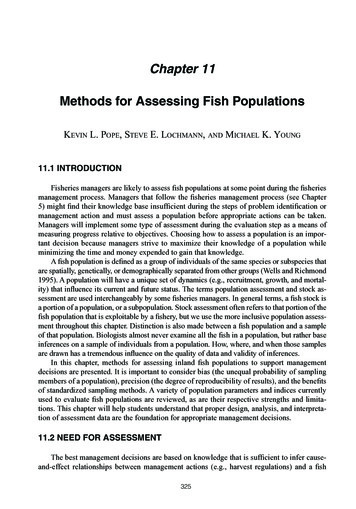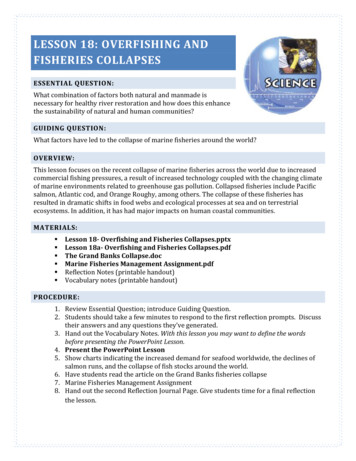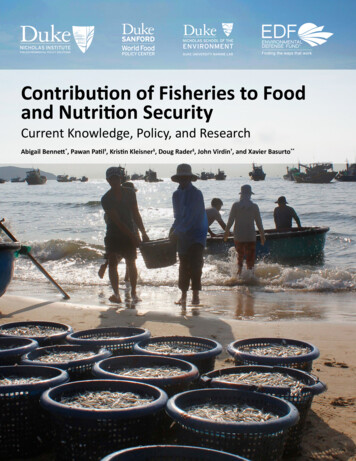
Transcription
NICHOLAS INSTITUTEFOR ENVIRONMENTAL POLICY SOLUTIONSContribution of Fisheries to Foodand Nutrition SecurityCurrent Knowledge, Policy, and ResearchAbigail Bennett*, Pawan Patil‡, Kristin Kleisner§, Doug Rader§, John Virdin†, and Xavier Basurto**
Contribution of Fisheries to Food andNutrition SecurityCurrent Knowledge, Policy, and ResearchSummaryCONTENTSObjective and Approach4Executive Summary5Background8Current Knowledge12Implications for Public Policy19Data and Research23Conclusion30Appendix: Extended Data Tables32Glossary35References37Author AffiliationsWorld Food Policy Center, Duke UniversityWorld Bank§Environmental Defense Fund†Nicholas Institute for Environmental Policy Solutions, DukeUniversity**Nicholas School of the Environment, Duke University MarineLab*‡CitationBennett, Abigail, Pawan Patil, Kristin Kleisner, Doug Rader, JohnVirdin, and Xavier Basurto. 2018. Contribution of Fisheries toFood and Nutrition Security: Current Knowledge, Policy, andResearch. NI Report 18-02. Durham, NC: Duke University, owledgmentsSarah Zoubek (Associate Director, World Food Policy Center,Duke University) and Kelly Brownell (Dean, Sanford School ofPublic Policy, Duke University) led preparation of this report.Stephanie Prufer organized and coded literature sources.Dhushyanth Raju (lead economist, Office of the Chief Economist,South Asia Region, World Bank) was an invaluable collaborator.ReviewThis report was reviewed by Shakuntala Thilsted at WorldFish,Edward Allison at the University of Washington, and ChristinaHicks at Lancaster University.Published by the Nicholas Institute for Environmental Policy Solutionsin 2018. All Rights Reserved.Publication Number: NI Report 18-02Cover photo: crystaltmcIn the context of the recently agreed-on UnitedNations 2030 Agenda for Sustainable Development,which includes the goal to end hunger, achievefood security, and improve nutrition, this reportsynthesizes current understanding of capturefisheries’ contributions to food and nutrition securityand explores drivers of those contributions.Capture fisheries produce more than 90 millionmetric tons of fish per year, providing the world’sgrowing population with a crucial source of food.Due to the particular nutritional characteristics offish, fisheries represent far more than a source ofprotein. They provide essential micronutrients—vitamins and minerals—and omega-3 fatty acids,which are necessary to end malnutrition andreduce the burden of communicable and noncommunicable disease around the world. Yet thecontributions of fisheries may be underminedby threats such as overfishing, climate change,pollution, and competing uses for freshwater.To support the food and nutrition securitycontributions of capture fisheries, policies must bedeveloped both to ensure the sustainability of resourcesand to recognize tradeoffs and synergies betweenconservation and food security objectives. A growingbody of data and research focused specifically at theintersection of fisheries, nutrition, and food securitycan inform such efforts by improving understandingof fisheries’ production and distributional dimensions,consumption patterns, and nutritional aspects of fishin the context of healthy diets and sustainable foodsystems. This expanding body of knowledge canprovide a basis for more directly considering fisheriesin the food and nutrition security policy dialogue.This report serves as a contribution to the WorldBank’s regional flagship report on ending malnutritionin South Asia, scheduled for release in October 2018.
Nicholas Institute for Environmental Policy SolutionsThe Nicholas Institute for Environmental Policy Solutions at Duke University is a nonpartisan institute founded in 2005to help decision makers in government, the private sector, and the nonprofit community address critical environmentalchallenges. The Nicholas Institute responds to the demand for high-quality and timely data and acts as an “honestbroker” in policy debates by convening and fostering open, ongoing dialogue between stakeholders on all sides of theissues and providing policy-relevant analysis based on academic research. The Nicholas Institute’s leadership and staffleverage the broad expertise of Duke University as well as public and private partners worldwide. Since its inception,the Nicholas Institute has earned a distinguished reputation for its innovative approach to developing multilateral,nonpartisan, and economically viable solutions to pressing environmental challenges.nicholasinstitute.duke.edu; General contact: nicholasinstitute@duke.edu; Author: john.virdin@duke.eduWorld Food Policy CenterOperating within Duke University’s Sanford School of Public Policy and under the direction of food expert Kelly Brownell,the World Food Policy Center (WFPC) plays a critical role in catalyzing innovative thinking and coordinated action that isneeded to change policy; support strategic, effective solutions, and increase investments needed to end hunger, achievefood security, promote sustainable agriculture, and impact diet-related disease.wfpc.sanford.duke.edu; General contact: worldfoodpolicy@duke.edu; Author: abigail.bennett@duke.eduEnvironmental Defense FundEnvironmental Defense Fund, a leading international nonprofit organization, creates transformational solutions to themost serious environmental problems. EDF links science, economics, law, and innovative private-sector partnerships.By focusing on strong science, uncommon partnerships and market-based approaches, EDF tackles urgent threatswith practical solutions. EDF is one of the world’s largest environmental organizations, with more than two millionmembers and a staff of approximately 700 scientists, economists, policy experts, and other professionals working in 22geographies around the world on unique projects running across four programs. The organization’s oceans program aimsto create thriving, resilient oceans in our lifetimes that provide more fish in the water, more food on the plate and moreprosperous fishing communities, even with climate change.edf.org/oceans; General contact: edfoceans@edf.org; Authors: drader@edf.org, kkleisner@edf.orgDuke University Marine LabThe Duke University Marine Lab is a campus of Duke University and an academic unit within the Nicholas Schoolof the Environment. The Duke Marine Lab has a distinguished record of research and education in marine science,conservation, and governance and a strong international reputation with research interests spanning diverse taxa andincluding both human and natural systems. The mission of the laboratory is to be at the forefront of understandingmarine environmental systems and their conservation and governance through leadership in research, training,communication, inclusion, and diversity.nicholas.duke.edu/marinelab; General contact: ml-info@nicholas.duke.edu; Author: xavier.basurto@duke.edu 3
OBJECTIVES AND APPROACHObjectivesThis report synthesizes current understanding ofthe contributions of capture fisheries to food andnutrition security and explores drivers of thosecontributions. It addresses three overarchingquestions: (1) What contributions do capture fisheriesmake to food and nutrition security? (2) What is thecurrent policy dialogue regarding the links betweencapture fisheries and food and nutrition security? (3)What data are available to inform research and policydevelopment to support the contributions of capturefisheries to food and nutrition security?The report addresses these questions with the aim ofsituating dialogue squarely within the science-policyinterface. The overall goal is to provide a foundationof knowledge to inform the trajectory of research,policy, and practice that supports the role of capturefisheries in achieving sustainable development goals(SDGs) to end poverty (SDG1) and hunger (SDG2).ScopeBoth capture fisheries and aquaculture areimportant food production systems that can makecomplementary contributions to food and nutritionsecurity. The primary focus of this report is onfisheries, which provide diverse forms of nutritionto a wide range of people and which face significantthreats. This focus addresses SDG14 of the UnitedNations 2030 Agenda for Sustainable Development:to “conserve and sustainably use the oceans, seasand marine resources for sustainable development”as the “increasingly adverse impacts of climatechange (including ocean acidification), overfishingand marine pollution are jeopardizing recent gainsin protecting portions of the world’s oceans” (UN2015b; 2017, 15). Just as importantly, the emphasis oncapture fisheries acknowledges the unique threats toinland fisheries, including invasive species, pollutionfrom agricultural runoff, and competition with otherfreshwater uses such as hydropower, irrigation, andaquaculture (Youn et al. 2014).However, fully removing aquaculture fromdiscussions of capture fisheries is impossible. First,aquaculture influences the dynamics of capturefisheries in multiple ways. Second, some key dataand research do not differentiate between farmedand captured fish. Finally, despite the guidanceprovided by the definitions included in the glossaryof this report, the distinction between aquacultureGraphic credit: Micaela Unda 4
and capture fisheries is not always clear. For example, culture-based fisheries release hatchery-reared animals into the wildand aquaculture-based capture grows wild caught fish in captivity until they reach marketable size (Ottolenghi, Silvestri,Giordano, Lovatelli, and New 2004). Capture fisheries and aquaculture will inevitably play interconnected and, ideally,complementary roles in alleviating hunger and malnutrition.The actual contribution that fisheries can make to nutrition and food security depends on the supply, distribution, andutilization of fish. These dynamics inevitably rely on the sustainable and equitable governance of the world’s marine andinland fisheries, compelling us to look deeper into the knowledge, research, and policy that link fisheries governance withnutrition and food security. In this sense, the present report also aligns with the contemporary discourse on food andnutrition security that increasingly pays attention to the environmental sustainability and biodiversity of the food systemson which we depend (Berry, Dernini, Burlingame, Meybeck, and Conforti 2015; Powell et al. 2015).The literature review of this report summarizes research findings and data at the global level as well as in particularcountries and regions, including both developed and developing countries. The broad geographical scope aims to capturethe range of food and nutritional contributions that fish can make in combatting different manifestations of malnutritionand associated communicable and non-communicable health conditions. The prominence of research on the Pacificisland countries and territories (PICTs) and on Southeast Asia reflects the geographical emphasis of the body of reviewedliterature.MethodsThis report reflects a literature review of peer-reviewed articles, gray literature, and key reports from internationalorganizations. Most of the peer-reviewed literature was obtained through the Web of Science and ProQuest databases. Ineach database, key word searches using the search strings “fisheries AND nutrition” and “fisheries AND food security”returned a large number of results. Within the 500 most-relevant results, only those containing the term “fisheries” as wellas a food security or nutrition term in the abstract or keywords list were retained. Within the set of retained sources, onlythose that directly address the intersection of fisheries and nutrition, food security, or both were included in the review.This set excluded, for example, articles that mentioned the food security contributions of fisheries but did not discussor present findings related to such contributions. Articles that focused entirely or primarily on aquaculture were alsoexcluded. After the peer-reviewed literature search, gray literature was obtained from the websites of key organizations,such as the United Nations Food and Agriculture Organization (FAO), the WorldFish Centre, and the International FoodPolicy Research Institute (IFPRI). Finally, additional resources specifically related to nutrition and food security wereincorporated as needed. These resources included highly cited peer-reviewed literature on the health benefits of fish andreports available from the World Health Organization (WHO). During the literature review, sources were coded accordingto topical themes that encompassed the main categories of nutrition and food security contributions and the factorsand processes driving those contributions. The coding themes emerged inductively through a preliminary review of keyliterature sources.EXECUTIVE SUMMARYThis report aims to synthesize information on the contribution of capture fisheries to food and nutrition security and onthe potential for these food production systems to do more to help end hunger and malnutrition. The information herecomes from peer-reviewed articles, gray literature, and key reports from international organizations, including findingsand data at global, national, and subnational levels. Although knowledge about fisheries’ contributions to nutrition andfood security continues to increase, particularly in the wake of agreement on the United Nations Sustainable DevelopmentGoals, it has yet to sufficiently influence the policy realm, where explicit links between fisheries governance and foodand nutrition security need to be amplified. For that reason, this report’s assessment of emerging data and research paysattention to the distinct challenges and opportunities facing capture fisheries and, to a lesser extent, aquaculture.The Social Problem: Hunger and MalnutritionThe social problem targeted by this report is the continued prevalence of hunger and malnutrition worldwide andthe global commitment to end this problem by 2030 (Sustainable Development Goal 2). Between 2015 and 2016, theprevalence of hunger is estimated to have increased from 10.6 percent of the global population (777 million people) 5
to 11 percent (815 million people). Essentially 1 in 10 people on the planet suffers from hunger. More than one in fivechildren are stunted—have low height relative to weight—often indicating undernutrition or micronutrient deficiency.The problem has many dimensions, often intersecting with geography (i.e., the “birth lottery”). For example, the highestrates of undernourishment and child stunting are in Africa, where one in five people is undernourished (one in three inEastern Africa); the highest absolute number of undernourished people are in Asia (519.6 million). Child wasting—lowweight relative to height—occurs in 9 percent of children under the age of five in Asia and in 16 percent of such children inSouthern Asia. At the same time, the prevalence of children under age five who are overweight is increasing in all regionsof the world.The Role of Capture Fisheries Food Production Systems in Helping to Solve the ProblemThe world’s capture fisheries are major food production systems that could play a larger role in meeting SDG2. Since1945, the FAO has promoted the role of capture fisheries in ending hunger, but in the last seven years, the number ofresearch publications on the topic has grown substantially. This trend reflects the fact that, unlike some staple foods suchas rice and other grains, fish is unique in that it has the potential to address multiple dimensions of food and nutritionsecurity simultaneously.Capture (or wild-caught) fisheries and aquaculture (farmed fish production) together produced 167.2 million metrictons of fish in 2014. That amount is equivalent to 20 kilograms per capita annually and to 17 percent of animal proteinconsumed by the global population. In 2014, the split in production between capture fisheries and aquaculture was roughlyhalf and half, though a greater proportion of aquaculture production was destined for human consumption (e.g., someof the products from capture fisheries provide feed for aquaculture and livestock). Within capture fisheries, nearly halfof production is from smallholders, or “small-scale fisheries,” which also employ an estimated 90 percent of the world’sfishers, almost all of whom live in developing countries.This global supply of fish from both capture fisheries and aquaculture provides nearly one-fifth of the average per capitaanimal protein intake for more than 3.1 billion people. Given that subsistence fishing (fishing for own consumption) andinformal trade is often underreported in official statistics, this number may underestimate the contribution of fisheries.This contribution is much higher in a number of regions, countries, and communities. For example, the populationsof some countries (Maldives, Cambodia, Sierra Leone, Kiribati, Solomon Islands, Sri Lanka, Bangladesh, Indonesia,and Ghana) obtain more than half of their animal protein from fish. In countries such as Iceland, Japan, Norway, theRepublic of Korea, and some small island developing states (SIDS) where fish is the most available animal protein source,fish provide almost four times the global average of animal protein in terms of dietary energy. In aggregate, developingcountries consume an annual per capita average of 18.8 kilograms of fish, and low-income, food-deficit countries consume7.6 kilograms of fish, falling below the global average. Yet these countries tend to rely on fish for a greater portion of theiranimal protein than the global average, even when total consumption levels are lower. Fish is typically more affordable thanother animal-source foods (ASFs), and it plays an especially important dietary role in countries in which access to animalprotein is low and staple foods such as rice, wheat, corn, roots, and tubers predominate.The most important contribution of fish are multiple micronutrients essential to addressing a variety of health issuesworldwide. Fish contain vitamin A, D, and B and calcium, phosphorus, zinc, iron, and iodine. Precise nutrient profilesvary across fish species, processing and preparation techniques, and habitat. Micronutrients in fish can lead to a variety ofhealth benefits, including lowered risk of cardiovascular disease; positive maternal health and pregnancy outcomes andincreased early childhood physical and cognitive development; improved immune system function; and alleviated healthissues associated with micronutrient deficiencies such as anemia, rickets, childhood blindness, and stunting. Vitamin Ddeficiency alone is a prevalent health issue worldwide. It can lead to rickets in children, affect bone health in adults, and isassociated with increased risk of common cancers, autoimmune diseases, high blood pressure and cardiovascular diseaseas well as communicable diseases. For pregnant women, insufficient levels of vitamin D are associated with increased riskof preeclampsia, gestational diabetes, preterm birth, and low birth weight. Vitamin A deficiency is the leading cause ofpreventable childhood blindness and can also contribute to weakened immune system and anemia, given that it supportsthe body’s use of iron. Vitamin B is also important in combination with iron and folate to prevent anemia and a number ofneurologic and cognitive problems. Similarly, the minerals available in fish can help address a number of health issues, forexample, iron deficiency, which leads to anemia (estimated to affect about 800 million women and children worldwide),and zinc deficiency, which correlates with the prevalence of child stunting. 6
The global fish supply also provides crucial fatty acids, including omega-3 polyunsaturated fatty acids essential forcardiovascular and brain health. The consumption of fish or fish oil has been shown to be associated with a number ofbenefits to coronary health, for example, lowered risk of death and sudden death from coronary heart disease, ischemicstroke, atrial fibrillation, and congestive heart failure. Worldwide, 1.4 million deaths are attributable to diets low in seafoodsource omega-3 fatty acids. Fish consumption correlates with a 36 percent reduction in heart disease and heart attacks anda 12 percent reduction in mortality from all causes.Fish consumption is particularly important to women, infants, and children who have higher demand for micronutrientsand protein. In low-income countries, malnutrition accounts for 45 percent of mortality in children under age fiveand half of years lived with a disability for children age four and younger. In Bangladesh, the risk of child mortality issignificantly lower for children born during peak fishing seasons to mothers who have a preference for fish. One studyfound that a number of inland fish are capable of providing at least 25 percent of recommended nutrient intake acrossmultiple micronutrients for infants and pregnant or lactating women in Bangladesh. In Cambodia, nutrient-rich fish,especially wild-caught fish, are an essential part of the diets of infants and children, even those under 12 months of age.A study in Tanzania found that the breastmilk of women who consumed high levels of freshwater fish had levels of DHA(an important omega-3 fatty acid) even higher than those recommended for baby formulas. When consumed by mothers,the omega-3 fatty acids DHA and EPA from fish have been linked with improved infant and child cognitive development,reduced preterm delivery, and decreased risk of asthma, food allergy, and eczema in children. However, in many countries,the low amount and frequency of fish consumption among young children and late introduction of fish in complementaryfeeding of infants likely limits health benefits.Consumption of fish does carry some risk of exposure to toxic substances, such as polychlorinated biphenyls, dioxins,methylmercury, and, increasingly, microplastics. This risk varies dramatically by type of fish consumed as well as byenvironment. Primary concerns are with levels of methylmercury, which can cause neurodevelopmental problems inchildren and which may contribute to cardiovascular disease in adults, and polychlorinated biphenyls (PCBs) and dioxinsthat may lead to cancer risks. These risks are an important consideration for certain groups such as high consumers offish, the elderly, pregnant women, nursing mothers, and children. The general agreement of experts, however, is that thebenefits of consuming fish outweigh the risks, even at high consumption levels for the general population and moderateconsumption levels of most species for pregnant and lactating women.Public Policies Needed for Fisheries to Meet SDG2Although capture fisheries and aquaculture are both important food production systems to help end hunger andmalnutrition, capture fisheries are distinct in that a number of processes, if not addressed, stand to undermine their foodand nutrition contributions. In particular, population growth, overfishing, climate change, and trade are likely to alterthe volume and distribution of the supply from capture fisheries, potentially to the detriment of sufficient and equitableglobal food provisioning. The supply of fish from capture fisheries grew exponentially during the twentieth century untilpeaking in the 1990s, and it has essentially stagnated since that time as concerns of overfishing have grown (currently FAOcharacterizes 31 percent of assessed fish stocks as overexploited). A recent analysis predicts that 10 percent of the world willexperience deficiencies in essential micronutrients and fatty acids as a result of declining capture fisheries and that theseimplications will be concentrated in low-latitude developing countries.Even though some capture fisheries are overexploited and others at threat to join them, with the appropriate governancereforms, most could recover and contribute more to ending hunger and malnutrition. Estimates suggest that the world’smarine capture fisheries could sustainably contribute an additional 16 million metric tons annually with governancereforms to address overfishing. Policies to enact these reforms will need to grapple with the more general challengesassociated with governing common pool resources. Monitoring and enforcing rules limiting who can harvest theseresources and how much they can harvest are costly and difficult. Governance reforms can be particularly challengingwhen fish resources are highly mobile and in contexts in which the number of fishing vessels is high and in which fishingactivities are highly dispersed. Inland fisheries face unique governance challenges related to competition over alternativefreshwater uses. Any reforms will need to address the tradeoffs and synergies related to reducing fishing effort (orallocating freshwater resources) while maintaining a nutritious food supply and ensuring traditional access for small-scalefishers. Accordingly, policy interventions and responses will need to take into account distributional consequences as wellas geographically differentiated needs and vulnerabilities to short-term fluctuations in the supply of fish. 7
The potential health and nutrition payoff for recovering and sustaining these food production systems has often beenmissing in the global food policy dialogue. For example, SDG2 targets spell out concrete actions that are relevant almostexclusively to terrestrial agricultural food systems. Similarly, much of the current thinking about nutrition-sensitive foodsystems—that is, about the design of interventions specifically to support diverse diets and improve nutrition—generallyoverlooks the role of sustainable fisheries.A Research Agenda for Increasing the Contributions of Capture Fisheries to Ending Hunger and Malnutrition:The Food-Environment Nexus in the WaterAlthough overfishing has long been studied as one of the world’s major environmental problems, quantification of itseffects on food and nutrition security is lacking. Building a comprehensive understanding of the role that capture fisheriesplay in nutrition and food security entails integrating different data sources to address a number of key questions. Data onthe production and distribution of fish provides a baseline for understanding the extent to which fisheries can contribute tofood and nutritional needs in different places. Data on fish consumption patterns, typically collected at the household level,lend further insight into how fish supply translates into food provision. Consumption data can also serve to triangulateand add granularity to production and trade data. Knowledge about the nutrient profiles of different fish and the waysthat processing, preservation, and preparation techniques affect nutritional characteristics can augment understandingof potential nutritional contributions associated with different fish consumption patterns. Dietary guidelines andrecommended nutritional intakes for different populations then provide a basis for understanding the significance ofnutrition from fish consumption with respect to individual nutritional requirements. Finally, these data can be situatedwithin the broader context of global food and nutrition security, informing a more comprehensive understanding of wherefish currently support good nutrition or could contribute more to alleviating particular forms of malnutrition. Althoughsome of these data are established or emerging, they face substantial challenges related to reliability and comparability.Furthermore, these sources of information have only begun to be integrated to improve understanding of the current andfuture contributions of fisheries to food and nutrition security.Fisheries policy that attends explicitly to food and nutrition security dimensions will depend on research that enhancesunderstanding of both the magnitude of fisheries’ contributions as well as the factors that affect the distribution,access, and use of fisheries resources. A critical need, given evidence that many capture fisheries are overexploited, isunderstanding of the implications of reducing fishing effort on food and nutrition security. Accurately predicting andevaluating the effects of any policy on that security is challenging from a methodological standpoint. However, the morethat research explicitly attends to these effects, the better it stands to inform integrated, coherent, and equitable policy.Key research topics include the role of gender dynamics, interactions between fisheries and aquaculture, thedistributional consequences of trade, and the climate footprint of fisheries vis-à-vis other food production systems.Understanding the contributions that capture fisheries make to food and nutrition security requires more rigorous andsystematic research on multiple drivers of fish supply distribution (for example, trade and climate change), particularlybecause the challenge of ending hunger and malnutrition may be focused as much on distribution as on sustainablyincreasing food supply. Furthermore, the geographic scope of research would need to be expanded, because most ofthe research to date has taken place in a relatively small number of countries or regions, notably the United States,Pacific Island countries and territories, Bangladesh, and Cambodia. Although the body of research explicitly aimedat understanding linkages between capture fisheries and nutrition and food security is growing, it is nonethelessincipient. More robust evidence is needed to evaluate the multiple pathways (for example, direct consumption, income,empowerment of women, macroeconomic growth) through which fisheries contribute to nutrition and food security.BACKGROUNDFostering sustainable ways to provide adequate food and nutrition to the world’s growing population is an urgent challenge,prioritized as the second of 17 SDGs (UN 2015b). Recent projections indicate that the world’s current population of 7.6billion people is likely to grow by another bil
†Nicholas Institute for Environmental Policy Solutions, Duke University **Nicholas School of the Environment, Duke University Marine Lab Citation Bennett, Abigail, Pawan Patil, Kristin Kleisner, Doug Rader, John Virdin, and Xavier Basurto. 2018. Contribution of Fisheries to Food and Nutrition Security: Current Knowledge, Policy, and Research.

